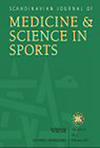训练有素的男性运动员在足球专项运动方案中早期和后期模拟高峰强度期间的肌肉代谢和表现。
IF 3.8
2区 医学
Q1 SPORT SCIENCES
引用次数: 0
摘要
我们应用了一个模拟最激烈的5分钟比赛时期的新模型来研究在模拟足球比赛早期和后期发生的峰值强度运动对肌肉代谢和疲劳的反应。11名训练有素的男性球员完成了一项改进的模拟足球比赛(哥本哈根足球测试),在早期插入了5分钟的高峰强度期模拟(PP1;10-15 min)和后期(PP2;85-90分钟)。在每个高峰前后分别进行肌肉活检和血液取样。肌糖原在两个高峰期均下降(p < 0.001), PP1下降62±46 mmol kg-1 dw, PP2下降25±37 mmol kg-1 dw,尽管有数值趋势(p = 0.115),但PP1和PP2的糖原分解没有统计学上的显著差异。肌乳酸在两个高峰期间均增加(p < 0.001),分别为47±25 mmol kg-1 dw和32±12 mmol kg-1 dw,增幅无明显差异(p = 0.108),尽管PP1期血乳酸水平比PP2期升高更多(p = 0.031), PP1期血乳酸水平更高(13.9±3.6 mmol L-1比9.8±2.4 mmol L-1, p = 0.003)。肌肉ATP下降4% (p = 0.004),磷酸肌酸下降约50% (p < 0.001)。PP2的RPE较高(10.0±0.0 AU比9.2±0.8 AU, p = 0.023),而10米冲刺性能下降约10% (p < 0.001), PP1和PP2之间无差异(p = 0.280)。总之,在模拟比赛早期出现的5分钟高峰时段引起了高无氧能量转换,显著的肌糖原减少,乳酸积累和PCr消耗。虽然高峰后期的高能磷酸盐代谢保持不变,但糖原溶解率出现减弱,同时感觉运动强度加重,但短跑成绩也出现类似的下降。本文章由计算机程序翻译,如有差异,请以英文原文为准。
Muscle Metabolism and Performance During Simulated Peak-Intensity Periods Occurring Early and Late in a Soccer-Specific Exercise Protocol in Well-Trained Male Players.
We applied a novel model mimicking the most intense 5-min game periods to investigate muscle metabolic and fatigue responses to peak-intensity exercise occurring early and late in a simulated soccer game. Eleven well-trained male players completed a modified simulated soccer game (the Copenhagen Soccer Test) with 5-min peak-intensity period simulations inserted early (PP1; 10-15 min) and late (PP2; 85-90 min) in the game. Muscle biopsies and blood samples were obtained before and after each peak period. Muscle glycogen decreased during both peak periods (p < 0.001) by 62 ± 46 mmol kg-1 dw in PP1 and by 25 ± 37 mmol kg-1 dw in PP2, without a statistically significant difference in the glycogen breakdown in PP1 vs. PP2, despite a numerical trend (p = 0.115). Muscle lactate increased during both peak periods (p < 0.001) to 47 ± 25 mmol kg-1 dw and 32 ± 12 mmol kg-1 dw, with no clear difference in the increase (p = 0.108), despite blood lactate levels rising more in PP1 vs. PP2 (p = 0.031), reaching higher post PP1 levels (13.9 ± 3.6 mmol L-1 vs. 9.8 ± 2.4 mmol L-1, p = 0.003). Muscle ATP decreased by 4% (p = 0.004) and phosphocreatine by ~50% (p < 0.001) following both peak periods. RPE was higher during PP2 (10.0 ± 0.0 AU vs. 9.2 ± 0.8 AU, p = 0.023), while 10-m sprint performance declined by ~10% (p < 0.001), with no differences between PP1 and PP2 (p = 0.280). In conclusion, a 5-min peak period occurring early in a simulated game elicited a high anaerobic energy turnover, with marked muscle glycogen reductions, lactate accumulation, and PCr depletion. While high-energy phosphate metabolism remained similar during the late peak period, glycogenolytic rate appeared attenuated, accompanied by aggravated perceived exertion but similar sprint performance deteriorations.
求助全文
通过发布文献求助,成功后即可免费获取论文全文。
去求助
来源期刊
CiteScore
7.90
自引率
4.90%
发文量
162
审稿时长
3 months
期刊介绍:
The Scandinavian Journal of Medicine & Science in Sports is a multidisciplinary journal published 12 times per year under the auspices of the Scandinavian Foundation of Medicine and Science in Sports.
It aims to publish high quality and impactful articles in the fields of orthopaedics, rehabilitation and sports medicine, exercise physiology and biochemistry, biomechanics and motor control, health and disease relating to sport, exercise and physical activity, as well as on the social and behavioural aspects of sport and exercise.

 求助内容:
求助内容: 应助结果提醒方式:
应助结果提醒方式:


